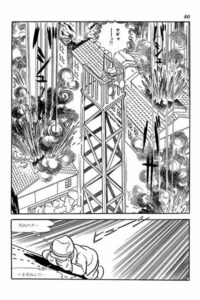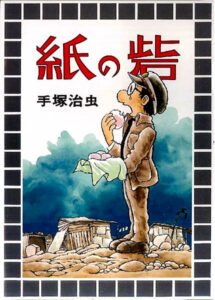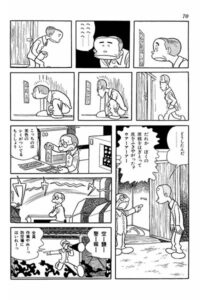Paper Fortress (Manga)
also known as 紙の砦 (Kami no Toride)
| English Title: | Paper Fortress |
| In English? | No |
| Japanese Title: | 紙の砦 Kami no Toride |
| Type: | Short Story |
| Original run: | 1974/09/30 |
| Published in: | Weekly Shonen King 週刊少年キング |
| Published by: | Shonen Gahosha |
| Volumes: | 1 (MT-274) |
The semi-autobiographical short story Paper Fortress (1974) was originally published as a short story in the September 30, 1974 issue of Weekly Shonen King.
What it’s about
In 1944, High School student, Osamu Tetsuro is jostled while getting off the train and has the contents of his portfolio dumped on the ground. As he scrambles to pick up his artwork, he gets an unexpected helping hand from a beautiful young woman named Kyoko Otamoto. The pair strike up a conversation and Tetsuro shares his dream to be a manga artist and Kyoko reveals she dreams of being a star in the Takarazuka Review. However, back at school there’s no time for such frivolities as ever citizen must begin homeland defence training in anticipation of an imminent invasion by the allied forces.
With his military instructor making his life a living hell, Tezuka is soon transferred to a munitions factory. Although the work is hard, it does afford Tetsuro the opportunity to steal away and work on his manga. However, manga without an audience is a useless thing, so, on the advice of a friend of his, Tetsuro posts his latest manga up on the wall in the toilets for everyone to enjoy. He is also reunited with Kyoko, who works nearby at the food depot, but who has joined the women’s choir. Of course, there’s no real escape from the war and the area falls victim to a firebomb attack. Kyoko’s home is utterly destroyed and Tetsuro – who was trying to finish up a manga page – is beaten after he is forced to take shelter with the women during an air raid.
Afterwards, Tetsuro is forced to stand watch and is caught outside when the next raid comes. Although he is badly burned in the raid, Kyoko’s face is severely injured in the. At first Tetsuro and Kyoko just try to survive the carnage, but they come across a group of people gathered around a downed American plane, Tetsuro is quickly filled with rage. And yet, seeing the already beaten-to-death pilot’s body, Tetsuro is simply shocked and horrified by every aspect of the war.
Although the war soon came to an end, Kyoko disappeared soon afterwards. However, Tetsuro never forgot her, and her face has influenced his manga artwork ever since.
What you should know
Understandably, Osamu Tezuka’s experiences during World War II had a large impact on both his life and his career. His “anti-war” theme pervades many of his works, and pops up everywhere, in such works as The Devil of the Earth (1954), Astro Boy (1962-68), The Adventure of Rock (1952-54), Captain Ken (1960-61), Castle of Dawn (1959-61), and many many others.
However, in the 1970s, Osamu Tezuka suddenly decided to make his anti-war theme a lot more personal. Instead of hiding his message behind a facade of sci-fi action or historical drama, he began publishing thinly veiled autobiographical short stories of his war-time experiences.
The reason for this is likely a combination of factors – the never-ending war in Vietnam, Tezuka’s own professional issues starting to rear their head, the social change going on in Japan, and the outside influence of other manga artists beginning to tackle the subject.
Regardless of the reason, Tezuka took each opportunity to convey some facet of his war-time experience. In Zephyrus (1971) he explored his own love of insects during a boyhood touched by war. In The Godfather’s Son (1973), he showed the power of manga to bring two very different people together, only to have it end due to the tragic circumstances of war. And later, in Mount Monmon is Crying (1979), he wistfully took a look back on how the war affected the beloved green spaces around his hometown. However Paper Fortress (1974), and its sequel, Hungry Blues (1975) focus more directly than any of the other stories on the straight up horrors of war that Osamu Tezuka himself experienced personally.
As Yuki Tanaka notes in his essay, War and Peace in the Art of Tezuka Osamu: The humanism of his epic manga (Asia Pacific Journal, Sep 20, 2010):
“Tezuka experienced the fire-bombings of Osaka while working at the arsenal. He was often reprimanded for drawing comics rather than concentrating on his work and as punishment he was ordered to climb the watchtower in the factory yard to look out for B-29 bombers and give the warning if he saw them. He later described one air raid:

The firebombs fall
‘As the air raid warning siren began, I saw that as usual, a formation of U.S. bombers was heading towards us along the Yodogawa River. As soon as I thought “here they come,” incendiary bombs showered down on us, making a loud noise like a heavy rain. Bombs streamed down one after another onto the factory. Just when I thought that this would be the end of my life, exposed on the top of the watchtower, a bomb hit the roof just two meters directly below me. Later I heard that this bomb killed all the people who had rushed into the air raid shelter underneath this building. I tumbled down the watchtower, screaming as if I had gone mad. All around me, the ground was a sea of fire … and houses in every direction were burning with leaping flames making a rumbling sound. Then rain with black soot came down. I walked to the top of the riverbank of the Yodogawa. From there, I saw many big craters hollowed by bombs, where numerous objects which resembled human bodies were lying on top of one another (The bodies were so fractured that they did not look like human beings.)’
In 1974, Tezuka produced the autobiographical manga entitled The Paper Fortress (Kami no Toride), describing this unforgettable experience. His miraculous survival during this fire-bombing episode had a profound impact on his ideas of war and peace, and also imbuing him with a deep mistrust of military leaders and politicians. He also feared the abuse of scientific knowledge which could create destructive weapons such as firebombs and atomic bombs.”
As such, Paper Fortress (1974) should be considered one of the most personal of all of Tezuka’s works. Besides depicting the horrors of his war-time experience, we are also treated to both the real-life episode of Tezuka posting his latest manga pages in the munitions factory toilet as a way to secretly get his manga out to an audience. We also get to share a few moments of joy in Tezuka’s love for the all-woman theatre troupe, the Takarazuka Review. More than any of his other stories, Paper Fortress (1974) gives his readers a chance to know what it was like to be a young Osamu Tezuka in the waning years of World War II.
Stars Spotted:
-
-
- Osamu Tezuka as “Osamu Tetsuro”
- Mokusan as “a member of the station staff”
- Shunsaku Ban as “a man in the crowd”
- Baba Noboru as “a man in the crowd”
- Nonki Megane as “a man in the crowd”
- Noracula as “the military teacher”
- Duke Red as “head of the munitions factory”
- Notaarin as “an officer at the munitions factory”
- Fujimoto Hiroshi as “Tetsuro’s friend”
- Odawara Chochin as “an officer at the munitions factory”
-




